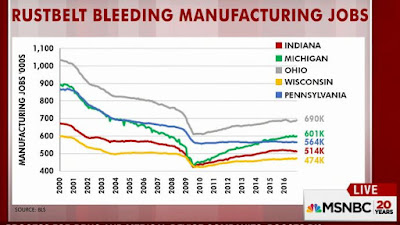Every so often on Morning Joe, they have Steve Rattner give the status of some economic condition. I thought Rattner presented two very compelling charts on the December 1, 2016 show that I have captured related to some of the angry feelings in the Midwest towards government. Of course one should notice in the figure that the steep decline in Rust Belt manufacturing jobs started well before the Great Recession, mostly during the administration of George W. Bush, with a particularly steep drop ("waterfall") going into the Great Recession. Such improvement as there has been was during the administration of Barack Obama. Note that with the Obama administration the decline in manufacturing workforce has stopped and has even started a slow recovery in all the states except Pennsylvania. You would think that workers would be happy that the decline (the bleeding so to speak) has not only stopped, but actually has slowly reversed in most states. However, we are told they aren't happy at all, so the reason for their anger must be sought elsewhere, such as the emotional effects of the Great Recession (see Part 1). but before we get too hysterical about this, please recall that Trump won these states by very small margins Michigan by less than 11,000 votes out of more than 4.8 million votes cast and Wisconsin by 27,200 out of 2.9 million votes cast and for Pennsylvania won by 46,530 votes out of nearly 6.9 million votes cast.), so maybe many people were grateful for the progress after all.
Below is some of the text of Rattner's presentation (in italics):
(Click on figure to enlarge)
The role that white working class voters played in Trump’s election is now widely accepted; this chart provides graphic back up for how tough it has been for these workers over nearly two decades and how minimal the much vaunted renaissance of manufacturing has been. ... Pennsylvania, once the home of the steel industry, has had no recovery in manufacturing jobs since the financial crisis.
Only Michigan – thanks to the success of the auto industry – has shown a meaningful rebound in manufacturing jobs and even Michigan’s total is still just two-thirds of what it was at the peak.
It’s important to recognize that not all these job losses are due to trade or globalization; improving efficiency also played a role in the lower need for workers (although those productivity gains have been minimal in the last several years.)*
(Click on figure to enlarge)
Note in the above figure, that although jobs have had a rebound in Michigan, the decline in wages that started long before the Great Recession has continued since, though at a slower pace. One can see some cause for anger there. Something like "It is nice to see my friends get back to work, but not at the expense of my wages."
In contrast, although Pennsylvania has not seen a rise in manufacturing employment, those remaining have seen the largest increase in wages of the five states and actually are even back to 2003 levels. One might wonder why manufacturing workers in Pennsylvania are so angry as the current workforce has bounced back in wages.
Certainly a part of the problem for the slow wage recovery was lack of a meaningful infrastructure program as construction (among other occupations) was very hard hit by the Great Recession.
Steve Ratner continues:
While attention mostly is focused on jobs, it’s important to recognize that falling wages are also a problem – and nothing in Trump’s announcement will address that problem, which is directly a result of trade and globalization, not automation [Emphasis added. See comment below]. In this category, Michigan – again because of the strong presence of the auto industry – has been the hardest hit, with average hourly wages in manufacturing falling from $28 per hour in 2003 to just over $20 per hour at present. (These numbers are all adjusted for inflation.)*
Though I have great appreciation for him, Rattner is certainly wrong that automation has had nothing to do with the decline of wages by workers. The wages actually must be below the costs of automation as well as achieve some sort of parity with the wages of the lowest cost countries.** Low wages in many countries, however, are tempered by the costs of shipping and some other factors like the generally higher price of natural gas in foreign countries. Thus the cost of selling something in the US. made in China may be more equivalent to, let's say, $8/hr (as a guess) rather than the $4/hr cost of labor in China, still a large difference.
I get the feeling that the manufacturing worker has been thrashing around for some years, trying to seek a political solution to the decline in manufacturing in the Rust Belt. In 2008, these people not only changed the "coach" (the president) but also the "team" (the Senate and two years earlier the House). Now in 2016, they changed the coach again, but left the team essentially in place. We should remember that the President-elect won these Rust Belt states by very small margins, suggestiong to me a high level of confusion. In the 2016 election they actually chose a n"coach" who was in confilct, not only with most of the Democratic Party but the Republican Party establishment as well but left the "team" essentially in place. We will see how that works out.
(Click on figure to enlarge)
Adding to their problems is that the American worker has been convinced to disarm and abandon unions. The decline in wages has paralleled the decline in unions.*** While unions may not be very effective, they are workers only hope in dealing with management.
* http://stevenrattner.com/2016/12/morning-joe-charts-putting-trumps-carrier-deal-in-context/
** http://stopcontinentaldrift.blogspot.com/2014/05/plight-of-american-workers.html
*** http://stopcontinentaldrift.blogspot.com/2013/10/a-race-to-bottom.html




No comments:
Post a Comment